Terrorcore is an extreme offshoot of hardcore techno that emphasizes very high tempos, heavily distorted kick drums, and horror-themed aesthetics. Tracks typically run from roughly 190–230 BPM or faster, using clipped, overdriven 909-style kicks and harsh percussion to create a relentless, punishing sound.
The genre draws on macabre imagery and sound design: eerie pads, atonal stabs, dissonant intervals, and samples from horror films, slashers, and news reports. Vocals—if present—are usually shouted, pitched-down, or sampled, serving texture more than narrative. Arrangement tends to be functional for dancefloors, with short breakdowns and abrupt, explosive drops that prioritize intensity over melodic development.
Terrorcore emerged in the Netherlands during the early–mid 1990s as a darker, faster strain of gabber/hardcore techno. Labels and party circuits in Rotterdam, The Hague, and Amsterdam fostered a competition for ever-harder sounds, with producers pushing BPMs upward and aesthetics toward horror, shock, and transgression. Industrial Strength (USA) and PCP-related circles in Germany also fed the movement’s darker sound design and sample culture.
By the late 1990s the term “terror” was common in event branding and on records, distinguishing these tracks from mainstream gabber. Crews and live acts amplified the theatrical side—masks, pyrotechnics, and horror visuals—while producers cemented production signatures: brickwall-distorted kicks, dissonant synth hits, and guttural or cinematic samples. The French and Italian scenes contributed a particularly hard edge, overlapping with industrial hardcore and prefiguring speedcore’s even higher tempos.
Online distribution and specialized festivals helped terrorcore circulate globally. Production techniques standardized around DAWs and modern distortion/saturation chains, while DJs interwove terrorcore with adjacent styles (industrial hardcore, speedcore, breakcore). Although niche, the genre remains a staple of extreme rooms at hardcore events, prized for its uncompromising energy and horror-centric atmosphere.
Terrorcore’s drive for extremity and its horror aesthetics directly influenced speedcore, splittercore, and extratone, and it helped shape the darker edges of industrial hardcore and breakcore. Its kick engineering and sampling approaches remain a reference point for producers seeking maximal, abrasive impact.
• Aim for 190–230+ BPM with a straight 4/4 pulse. Use short turnarounds and drop-focused phrasing to keep momentum.
• Program driving offbeat hats and sharp rides; add syncopated fills with toms and snare rushes for tension.
• Build the signature kick by layering a 909-style or synthesized sine kick with heavy distortion, clipping, and saturation. Shape a hard transient and long, tonal tail that occupies the low–mid.
• Use parallel distortion/saturation, transient shaping, and tight EQ notches to keep the kick dominant without muddying the mix.
• Add horror elements: screams, creaks, drones, reversed cymbals, metallic hits, and foley from horror films or field recordings.
• Keep harmony minimal and dissonant. Favor minor keys, tritones, diminished/augmented intervals, and atonal stabs.
• Use dark pads, low choirs, and detuned textures. Short, ominous motifs or risers work better than long melodies.
• Open with kick-only intros for DJ mixing, then layer hats, rides, and stabs. Use brief breakdowns with horror samples to reset energy before explosive drops.
• Employ stop–start edits, tape stops, and abrupt mutes to exaggerate impact. Keep sections concise (8–32 bars) to sustain intensity.
• Prioritize headroom for the kick. Use sidechain on bass, pads, and effects; carve midrange space for stabs and vocals.
• Limit aggressively but retain transient bite. Control harshness with multiband dynamics so the track stays loud yet intelligible on big rigs.


